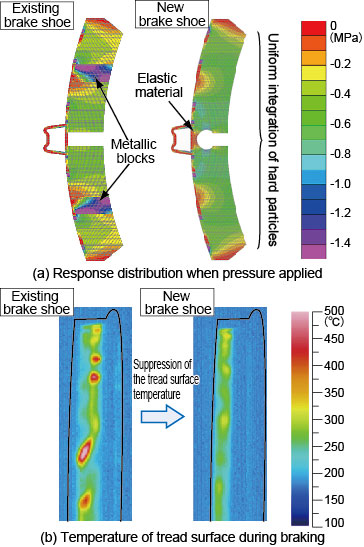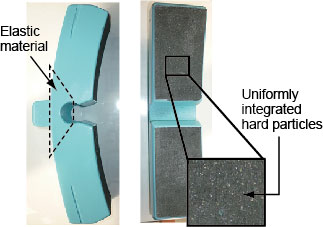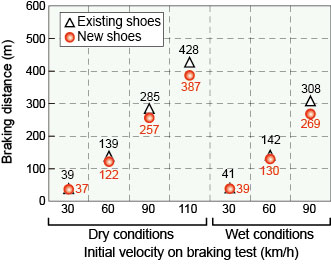1.Elastic composite brake shoe structure with capacity to reduce wheel damage
- An elastic composite brake shoe structure has been developed with enhanced capacity to adapt to the shape of the wheel.
- The developed brake shoe not only suppresses rises in temperature on the tread surface during braking, it also offers better braking performance in wet conditions, compared to the existing shoes.
The composite brake shoes commonly used today generally have a hard metallic component added to their structure aimed at keeping their friction coefficient in wet conditions. Investigations into the contact conditions between these brake shoes and wheels reveal concentrated points of stress and temperatures exceeding 500℃. It is hypothesized that an increase in thermal load in some of these zones could lead to thermal cracking damage to the wheel, inter alia (Fig.1).
Consequently, hard particles with a suitable grain size were used to replace the aforementioned metallic blocks, and a new elastic structure was developed which could easily adapt to the shape of the wheel (Fig.2).
The hard particles employed for the development of the new brake shoe are a by-product from the iron casting process, and are therefore a demonstration of efficient resource use.
While the newly developed shoe can limit the rise in temperature on the wheel tread surface thereby reducing wheel damage, such as thermal cracking, it was also found to have a better friction coefficient in wet conditions, compared with the existing brake shoe . During both wet and dry condition trials, braking distances with the newly developed shoe were 10% shorter than with conventional shoes (Fig.3).

Fig.1 Improvement in tread surface contact conditions
Fig.2 Figure illustrating the newly developed
composite brake shoe with elastic structure
Fig.3 Trials to determine the influence of
the new brake shoes on running test